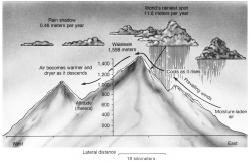|
This section contains 203 words (approx. 1 page at 300 words per page) |
 A rain shadow in Hawaii on the eastern side of Mount Waialeale. (McGraw-Hill Inc. Reproduced by permission.)
A rain shadow in Hawaii on the eastern side of Mount Waialeale. (McGraw-Hill Inc. Reproduced by permission.)
A region of relative dryness found on the downwind side of a mountain range or other upland area. As an air mass rises over the upwind side of a mountain range, pressure drops and temperature falls. This causes the relative humidity of the air mass to rise. Eventually the moisture in the air condenses and precipitation occurs. An air mass that is now cooler and drier passes over the top of the mountain range. As it descends on the downwind side of the range, it warms again and its relative humidity is further reduced. This reduction in relative humidity not only prevents further rainfall, but also causes the air mass to absorb moisture from other sources, drying the climate on the downwind side. The ultimate result is lush forest on the windward side of a mountain separated by the summit from an arid environment on the downwind side. Examples of rain shadows include the arid areas on the eastern sides of the mountain ranges of western North America, and the Atacama Desert in Chile on the downwind side of the Andes Mountains.
|
This section contains 203 words (approx. 1 page at 300 words per page) |


